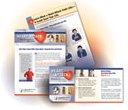How Can a Heart Attack Be Prevented?
Lowering your risk factors for coronary heart disease (CHD) can help you prevent a heart attack. (For more information about risk factors, go to "Who Is at Risk for a Heart Attack?")
Even if you already have CHD, you can still take steps to lower your risk for a heart attack. These steps involve following a heart healthy lifestyle and getting ongoing care.
Heart Healthy Lifestyle
Following a healthy diet is an important part of a heart healthy lifestyle. A healthy diet includes a variety of fruits, vegetables, and whole grains. It also includes lean meats, poultry, fish, beans, and fat-free or low-fat milk or milk products. A healthy diet is low in saturated fat, trans fat, cholesterol, sodium (salt), and added sugars.
For more information about following a healthy diet, go to the National Heart, Lung, and Blood Institute's (NHLBI's) Aim for a Healthy Weight Web site, "Your Guide to a Healthy Heart," and "Your Guide to Lowering Your Blood Pressure With DASH." All of these resources provide general information about healthy eating.
If you're overweight or obese, work with your doctor to create a reasonable weight-loss plan that involves diet and physical activity. Controlling your weight helps you control risk factors for CHD and heart attack.
Be as physically active as you can. Physical activity can improve your fitness level and your health. Talk with your doctor about what types of activity are safe for you.
For more information about physical activity, go to the Health Topics Physical Activity and Your Heart article and the NHLBI's "Your Guide to Physical Activity and Your Heart."
If you smoke, quit. Smoking can raise your risk of CHD and heart attack. Talk with your doctor about programs and products that can help you quit. Also, try to avoid secondhand smoke. For more information about quitting smoking, go to the Health Topics Smoking and Your Heart article.
Ongoing Care
Treat Related Conditions
Treating conditions that make a heart attack more likely also can help lower your risk for a heart attack. These conditions may include:
- High blood cholesterol. Your doctor may prescribe medicine to lower your cholesterol if diet and exercise aren't enough.
- High blood pressure. You doctor may prescribe medicine to keep your blood pressure under control.
- Diabetes (high blood sugar). If you have diabetes, try to control your blood sugar level through diet and physical activity (as your doctor recommends). If needed, take medicine as prescribed.
Have an Emergency Action Plan
Make sure that you have an emergency action plan in case you or someone in your family has a heart attack. This is very important if you're at high risk for a heart attack or have already had a heart attack.
Talk with your doctor about the signs and symptoms of a heart attack, when you should call 9–1–1, and steps you can take while waiting for medical help to arrive.
Featured Video
The NHLBI "Grand Opportunity" Exome Sequencing Project
-
 Heart Attack Warning Symptoms
Heart Attack Warning Symptoms
10/20/2011
Have questions about heart disease in women? Join The Heart Truth®, Million Hearts™, the American College of Cardiology, and Healthfinder.gov for a World Heart Day Twitter chat on September 28, at 1 p.m. eastern time. Learn more about the history of women’s heart disease research and ask live experts your questions. Go to www.twitter.com, and search for #HeartChat to join the chat.
Clinical trials are research studies that explore whether a medical strategy, treatment, or device is safe and effective for humans. To find clinical trials that are currently underway for Heart Attack, visit www.clinicaltrials.gov.
September 4, 2012
Silent heart attacks are common and predict risk of death, MRI diagnosis shows
Magnetic resonance imaging (MRI) is more effective than electrocardiography (ECG) at identifying "silent" heart attacks, also known as unrecognized myocardial infarctions, according to a study performed by National Institutes of Health researchers and international colleagues.

When a heart attack happens, any delays in treatment can be deadly.
Knowing the warning symptoms of a heart attack and how to take action can save your life or someone else’s.
The NHLBI has created a new series of informative, easy-to-read heart attack materials to help the public better understand the facts about heart attacks and how to act fast to save a life.
Click the links to download or order the NHLBI's new heart attack materials:
“Don’t Take a Chance With a Heart Attack: Know the Facts and Act Fast” (also available in Spanish)
“Heart Attack: Know the Symptoms. Take Action.”
“Learn What a Heart Attack Feels Like—It Could Save Your Life”
The NHLBI updates Health Topics articles on a biennial cycle based on a thorough review of research findings and new literature. The articles also are updated as needed if important new research is published. The date on each Health Topics article reflects when the content was originally posted or last revised.

















 The NHLBI "Grand Opportunity" Exome Sequencing Project
The NHLBI "Grand Opportunity" Exome Sequencing Project